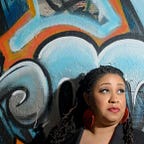Contemporary Cases of the Modern Boo Hag
According to African American folk-epistemology, a Boo Hag is a shapeshifter of nefarious repute*. Like their Caribbean counterparts — the soucouyants, Boo Hags are blood thirsty beings that sneak into homes to feast on sleeping bodies. Almost always depicted as unattractive women, these entities are known to shed their human skin disguises in order to travel the night in their true forms and enter unsuspecting victims’ homes to feast on blood. One thing is critical to the argument I am about to offer to you. It is:
Boo Hags are skinless shapeshifters that masquerade as humans in order to consume real humans.
In early September 2020, we were introduced to the curious case of scholar Jessica Krug. Despite working for years as a woman of color, Krug — a white Jewish woman from Kansas — wrote a confessional that revealed her true self. Krug did not initially come forward voluntarily though. It’s been reported that she only confessed and ended her masquerade because others were about to reveal her true identity; she was not who she pretended to be. Krug had decided to wear a disguise of an Afro-Latinx woman and enter into spaces and community relationships made possible by that disguise.
Not too long after, we encountered the case of CV Vitolo-Haddad. Vitolo-Haddad is a white USian woman who like Krug, constructed an identity for herself out of her understandings (and representations) of Afro-Latinx and Ethiopian cultures (among others).
Now most recently, we learn about Kelly Kean Sharp, a white woman claiming to be Chicana.
I’ve thought deeply about the motivations and behaviors of these white women and their needs to masquerade themselves cloaked in how they perceived “Otherness”. That is how I’ve come to understand these people as modern manifestations of the Boo Hag.
What might have inspired these women to shed their own skins (or be skinless) in order to wear the identities of women of color? I believe a consideration of the Boo Hag and its characteristics help explain this phenomenon.
Boo hags are vampiric spirits that prey on the essence of their victims in order to sustain their activities and themselves. Krug, Vitolo-Haddad, and Sharp all used what they observed (and assumed) about other cultures to enter into privileged community roles utilizing their (sometimes strange) (re)presentation of these cultures. Under their disguises, these women sought out resources intended for their victims and used them for nourishment of themselves.
The Boo Hag’s only known way of sustaining itself is by victimizing others. It has no skin of its own, cannot walk in sunlight, and must feed to live. Boo Hags rely on the cover of night and the sleepingness of their victims to survive. In fact, the best defense against the Boo Hag is its own preoccupation with counting and order. Hoodoo practitioners will often prescribe that Boo Hag victims salt their windows, doors, and around their bed or leave a broom with many bristles near the foot of the bed to distract the Boo Hag by its own need and preoccupation with counting. In this way, victims can distract the entity long enough that it ruins itself by letting the sun catch it in the morning.
It can be noted that the three cases of Krug, Vitolo-Haddad, and Sharp all include voluntary misrepresentation of culture, life, and identity in ways that allowed them to move under the cover of culture to sustain their disguises and feast on the substance, resources, and opportunities of unaware others.
While I have used the Boo Hag here as a means to hypothesize about the problems Krug and others present to people of color, it is important that I make a statement regarding how even in their likeness to the Diasporic creature, these women are distinct in that unlike the Boo Hag/soucouyant’s antisocial tendencies (Anatol, 2015; 2016), these white women have relied on their pretended social connections to feed upon a community identity. People who have experienced these women and their disguises have reported feeling duped and betrayed.
To be sure, Boo Hags are no friends to their victims. Any pretended relationships are simply undertaken to serve the interests of the Boo Hag alone. It gains its entry by appearing to be non-threatening and in their sleepy state of nonawareness, its victims do not recognize it until the feast has begun. Boo Hags are tricksters. They do and say whatever is necessary to enter into the homes of their victims. I wonder what these women did and said to be welcomed into community settings — settings usually reserved for our allies and for ourselves. What whispered promises and pretended oaths did these women utter to gain entry? In what ways might their victims have been better prepared to recognize vampirism in their midst?
There is a lesson in the Boo Hag for our people.
*Importantly, there have been scholarly challenges problematic depiction of Boo Hags and soucouynats as single anti-social women. This is an important acknowledgement to make although I do not do so here.
**These article will appear in an expanded form in a forthcoming book.
References and Resources:
Anatol, G. L. (2015). Things that fly in the night: Female vampires in literature of the Circum-Caribbean and African Diaspora. NJ: Rutgers University Press.
Anatol, G. L. (2016). From granny’s knee to graduate seminar: The travels of the soucouyant. In M. Graham & Raussert, W.’s Mobile and Entangled America(s) (pp. 91–102). NY: Routledge.
Dobson, K. & Chariandy, D. (2007). Spirits of elsewhere past: A dialogue on Soucouyant. Callaloo, (3), 808–817.
